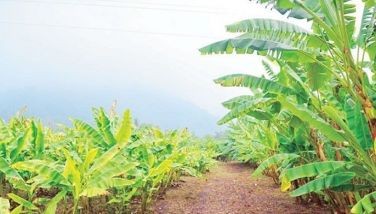Banks to ramp up lending to agriculture – survey
MANILA, Philippines — Philippine banks are ramping up lending to the agriculture sector in the next 12 months to support the country’s strong economic growth, the results of a survey jointly conducted by the Bangko Sentral ng Pilipinas (BSP) and the Department of Agriculture (DA) showed.
Based on the 2021 Countryside Bank Survey (CBS) Baseline Report, at least three-fourths or 76 percent of bank branches in the survey plan to expand their lending to the agriculture sector in the next 12 months.
The results of the survey showed that majority of thrift banks affirmed plans to expand their agricultural loan portfolio.
Factors encouraging banks to expand lending to agriculture sector include to respond to increasing demand for agricultural loans as the COVID-19 pandemic is getting controlled and to serve as compliance to the mandatory credit allocation.
Furthermore, banks also want to fulfill their mandate to extend agricultural loans to help farmers expand their businesses and improve their quality of life, as well as to provide for the farmers’ financing needs and stop them from availing high-interest rate loans from informal lenders.
The country’s banking sector also wants to support the nation’s goal of attaining food security, financial stability, and economic development.
In 2021, the share of agriculture to total loans granted in most banking units ranged from 11 to 15 percent of total loans, which is lower compared to the 2020 level.
Likewise, the number of agricultural borrowers declined by at least 30 percent in 2021 from 2020.
Across the different types of banks, at least 26 percent and 36 percent from respondent banks of rural and cooperative banks, as well as government-owned banks, respectively, reported that their total agricultural borrowers were comprised of at least 76 percent small agricultural borrowers.
The survey showed that demand for agricultural loans in 2021 remained relatively tepid amid the low policy rate environment.
Banking units imposed rates on agricultural loans that were at par with the average of all banking units in 2021, with rural and cooperative banks in the National Capital Region (NCR), as well as outside the NCR, and thrift banks posting lending rates that were higher than those of government-owned banks, as well as universal and commercial banks.
Nevertheless, about 62 percent of the respondent banks reveal a positive outlook following higher demand for agricultural loans in 2022.
As of end-June 2022, banks compliance to agrarian reform credit, which should be 10 percent of their total loanable amount of P8.22 trillion, was only 0.78 percent. Moreover, the percentage or ratio of compliance to the 15 percent other agricultural credit was only 9.53 percent.
Big banks released P796.59 billion agri-agra loans during the same period, up by 7.6 percent from the same period in 2021 of P740.32 billion.
Meanwhile, thrift banks’ loans to the agricultural sector and agrarian reform-related businesses also increased by 9.06 percent to P22.73 billion from P20.84 billion.
The smaller rural and cooperative banks’ lending posted minimal movement, only up by 0.45 percent to P28.63 billion from P28.50 billion.
Based on Republic Act 11901 or the Agriculture, Fisheries and Rural Development Financing Enhancement Act of 2022, banks are no longer required to allot 10 percent of their lending portfolio for agrarian reform beneficiaries and 15 percent for agricultural activities.
Instead, the amended law provides banks with “greater flexibility in allocating the combined 25 percent mandatory credit quota to a range of borrowers in the agriculture, fisheries, and agrarian reform sectors.
The 2021 CBS discusses the results of the inaugural survey jointly conducted by the BSP and the DA - Agricultural Credit Policy Council (DA-ACPC) aimed at analyzing detailed trends and present emerging policy issues on bank behavior towards lending to the agriculture sector using branch-level data.
The survey focused on the banking units’ agricultural lending experience in 2021 vis-a-vis 2020. It looked into the practices and outcomes of various aspects of branch banking operations, including agricultural loan releases and demand; interest rates and other charges on bank loans; borrowers’ repayment and debt position; bank risk management; bank profitability; problems encountered by banking units; effects of the COVID-19 pandemic on banking performance; and the plans and prospects by banks for the next year.
- Latest
- Trending





























